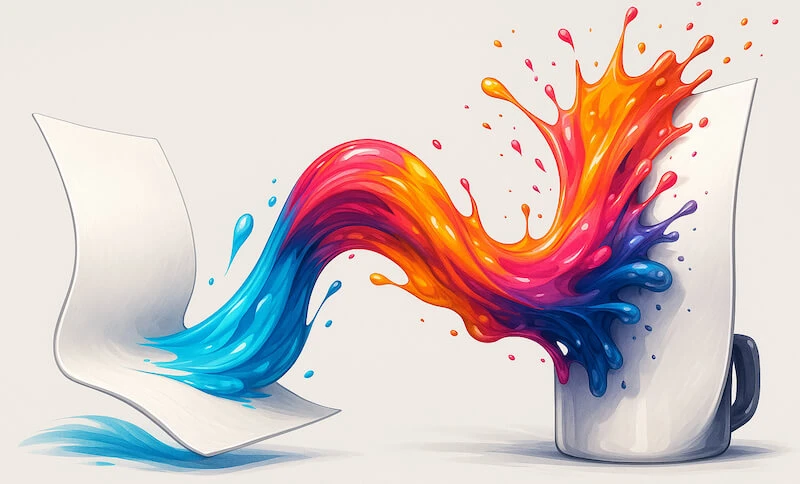Not all sublimation paper is created equal — and one of the biggest variables that affects color output, drying speed, and transfer sharpness is paper weight. Whether you’re pressing shirts, mugs, tumblers, or hard substrates, choosing the right paper weight can dramatically change the vibrancy and crispness of your final print.
Does sublimation paper weight matter?Yes. Sublimation paper weight affects ink absorption, drying time, and transfer sharpness. Lighter paper (100–120gsm) is best for fabric because it holds less moisture and releases it faster during pressing, preventing curling and ghosting. Heavier paper (120–140gsm or more) is better for hard substrates like mugs and metal because it holds more ink and stays rigid, reducing movement during taping and pressing.
In this guide, we explain how sublimation paper weight works, why weight impacts print results, and how to choose the right GSM for T-shirts, mugs, tumblers, and rigid substrates. By understanding how paper weight influences ink release and fiber contact, you’ll achieve sharper colors and more consistent transfers, without wasted prints.

Key Takeaways
Paper weight equals GSM (grams per square meter).
GSM is a measurement of paper weight that indicates how much one square meter of the paper weighs. Higher GSM = thicker, stiffer, absorbs more ink.
Fabric prefers lighter weight
100–120gsm reduces wrinkles and ensures flat contact for polyester shirts.
Rigid substrates prefer heavier weight
120–140gsm holds more ink and reduces shifting on mugs and tumblers.
There is no “best” GSM — only the right GSM for the job.
Match the paper weight to the substrate for sharper prints and consistent transfers.
GSM: The Measurement That Defines Sublimation Paper Weight
GSM (grams per square meter), is the standard measurement used to define sublimation paper weight. It tells you how much one square meter of the paper weighs, which directly indicates its paper thickness, paper density, and overall sheet weight. A higher GSM means a thicker, stiffer sheet with a heavier paper build and stronger paper structure.
Manufacturers use GSM as a universal weight classification, making it easier to compare different brands and types of sublimation paper. Because sublimation paper includes specialized coatings, the GSM also reflects factors like coating density, paper composition, and the sheet’s absorbency level, all of which affect how well it handles ink.
| 💡 How can a single GSM value account for coating, fiber makeup, and absorbency?GSM measures the total weight of the paper, not the weight of each component. It combines the fibers, coating layers, and absorbency additives into one figure, so two papers with the same GSM can still perform differently depending on how that weight is distributed. |
GSM also correlates with paper caliper (physical thickness) and print media weight, both of which influence how the paper behaves under heat and pressure. Understanding this material weight rating helps you choose the right paper for your substrate, whether you need flexibility for fabrics or rigidity for hard surfaces.
Why Lightweight Paper Performs Better on Fabrics
Lightweight, low-GSM sheets are ideal for apparel because they sit flat against soft substrates and create reliable fabric conformity during pressing. Their thin sublimation paper structure makes them a textile-friendly paper option, allowing smoother contact with shirts, hoodies, and other polyester garments.
A lighter, flexible paper stock also acts as a more breathable paper base, which helps it function as fabric transfer media without trapping excess moisture. This supports faster drying, making it a practical fast-dry paper for high-volume garment production.
Because lighter sheets manage moisture more effectively, they provide moisture-efficient performance and maintain wrinkle-resistant contact during heat application. This leads to more consistent garment sublimation performance and better shirt printing optimization, especially when you need smooth surface contact on apparel.
| 👉 If you’re dealing with humidity issues (even when using the right sublimation paper) check our guide on sublimation moisture problems for troubleshooting steps and prevention tips. |
Finally, lightweight paper has natural anti-curl behavior because it absorbs less moisture and dries quickly, helping it stay flat as the heat press reaches temperature, a key advantage on soft, flexible fabrics.
Why Heavyweight Paper Is Ideal for Hard, Rigid Surfaces
Heavier, high-GSM transfer sheets provide the stability needed for hard-surface sublimation, especially when working with mugs, tumblers, metal panels, and other rigid substrates. Their thick sublimation paper construction creates a more rigid paper stock, which helps prevent movement during taping and pressing.
The added stiffness gives these sheets strong non-flex transfer support, ensuring consistent stability during taping and better alignment on curved or solid items. This rigidity also improves dimensional stability under pressure, making them a reliable pressure-resistant transfer paper for demanding applications.
Because the paper has a more structured paper build, it can handle a high ink load without oversaturation. This leads to better enhanced ink retention, allowing for richer color output when pressing onto hard surfaces.
For workflows involving coated drinkware or metal blanks, heavy-duty sublimation sheets offer the best rigid substrate compatibility, providing predictable performance and cleaner results across a wide range of hard products.
Choosing the Right GSM Depends on Your Substrate, Not a Universal “Best”
There is no one-size-fits-all paper in sublimation. The ideal GSM changes based on the item you’re pressing, making substrate-specific GSM selection more important than finding a single “best” weight. Each substrate requires task-matched paper weight to achieve consistent results.
Effective application-based paper choice means selecting a project-appropriate paper that aligns with your material’s behavior under heat and pressure. This tailored paper selection focuses on print-to-substrate compatibility, ensuring the paper supports the surface it’s being pressed onto.
Because different products respond differently during pressing, situational GSM preferences matter. What works for apparel may not work for drinkware, and what works for metal may not work for coated MDF. Purpose-driven paper weight gives you the flexibility to match the paper to the specific product, supporting better print outcome optimization.
In practice, choosing GSM by material type leads to more predictable, context-dependent performance and helps you identify the best GSM for each use case, rather than relying on a single standard for all projects.
